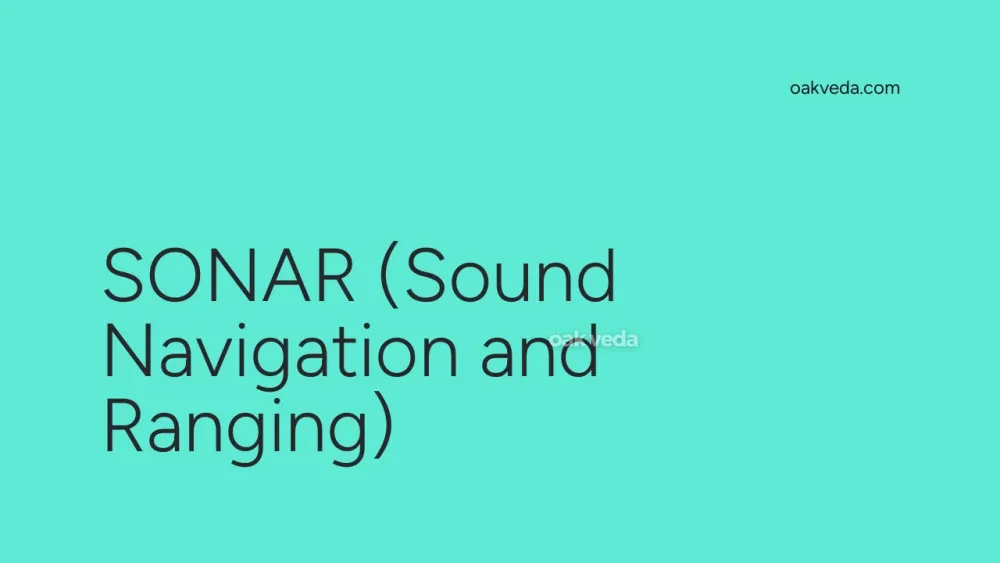
What is the Full Form of SONAR?
SONAR is an acronym with the full form "Sound Navigation and Ranging." This technology utilizes sound propagation to navigate, communicate with, or detect objects underwater. SONAR has revolutionized marine exploration, military operations, and scientific research in aquatic environments.
What is Sound Navigation and Ranging?
Sound Navigation and Ranging, commonly known as SONAR, is a technique that uses sound waves to detect and locate objects underwater. It works on the principle of sound propagation in water, where sound waves are emitted and their echoes are analyzed to gather information about the surrounding environment.
Origin and Development of Sound Navigation and Ranging
The concept of using sound for navigation dates back to 1490 when Leonardo da Vinci first experimented with listening tubes in water to detect distant vessels. However, modern SONAR technology emerged in the early 20th century, driven by the need for submarine detection during World War I.
The term "SONAR" was coined in 1942 by the U.S. Navy as an analogy to RADAR (Radio Detection and Ranging). Since then, SONAR technology has advanced significantly, finding applications in various fields beyond military use.
How does Sound Navigation and Ranging work?
The working principle of SONAR involves two main steps:
- Sound Wave Transmission: A transducer generates and emits high-frequency sound waves into the water.
- Echo Reception and Analysis: The same transducer or a separate hydrophone receives the reflected sound waves (echoes) from objects in the water. These echoes are then analyzed to determine the distance, direction, and characteristics of the detected objects.
The time taken for the sound wave to travel to the object and back is used to calculate the distance, while the strength and frequency of the echo provide information about the object's size and composition.
Types of Sound Navigation and Ranging
There are two primary types of SONAR systems:
Active SONAR
- Functionality: Emits sound waves and listens for echoes
- Components: Includes both a transmitter and a receiver
- Process: Transmits high-frequency sound waves in a specific direction and analyzes the returned echoes
- Natural Example: Echolocation used by marine mammals like whales and dolphins
Passive SONAR
- Functionality: Listens for sounds produced by underwater objects
- Components: Only includes a receiver
- Process: Detects and analyzes sounds coming from various underwater sources without emitting any signals
- Applications: Commonly used in underwater research and military surveillance
Functions of Sound Navigation and Ranging
SONAR serves several crucial functions in underwater environments:
- Object Detection: Locating underwater obstacles, vessels, or marine life
- Depth Measurement: Determining the depth of water bodies
- Navigation: Assisting in safe underwater navigation for submarines and ships
- Communication: Enabling underwater communication between vessels
- Seafloor Mapping: Creating detailed maps of the ocean floor
Applications of Sound Navigation and Ranging
SONAR technology finds applications in various fields:
- Military: Submarine detection, underwater mine detection, and naval warfare
- Marine Biology: Studying marine life behavior and populations
- Oceanography: Mapping ocean floors and studying underwater geological features
- Fishing Industry: Locating fish schools and determining water depth
- Offshore Oil and Gas: Underwater surveying and pipeline inspection
- Search and Rescue: Locating sunken vessels or underwater wreckage
Features of Sound Navigation and Ranging
Key features of SONAR technology include:
- High Precision: Provides accurate measurements of distance and depth
- Long-Range Detection: Can detect objects at considerable distances underwater
- Non-Visual Operation: Functions effectively in low-visibility underwater conditions
- Real-Time Data: Offers immediate feedback on underwater environments
- Versatility: Adaptable for various underwater applications
Benefits of Sound Navigation and Ranging
SONAR technology offers numerous advantages:
- Enhanced Underwater Awareness: Provides a clear picture of underwater environments
- Improved Safety: Aids in avoiding underwater obstacles and hazards
- Efficient Resource Exploration: Facilitates underwater resource discovery and mapping
- Advanced Scientific Research: Enables in-depth study of marine ecosystems and geology
- Increased Maritime Security: Supports naval defense and coastal surveillance
Limitations or Challenges of Sound Navigation and Ranging
Despite its benefits, SONAR technology faces some challenges:
- Environmental Impact: High-intensity active SONAR can potentially harm marine life
- Signal Interference: Background noise and water conditions can affect accuracy
- Limited Effectiveness in Shallow Waters: Performance may be reduced in shallow or highly cluttered environments
- Technological Complexity: Advanced SONAR systems can be expensive and require specialized training
Future Developments in Sound Navigation and Ranging Technology
The future of SONAR technology looks promising with ongoing advancements:
- AI Integration: Incorporating artificial intelligence for improved data interpretation
- Miniaturization: Developing smaller, more portable SONAR devices
- Eco-Friendly Solutions: Creating SONAR systems with reduced environmental impact
- Multi-Beam Systems: Enhancing resolution and coverage with multiple beams
- Autonomous Underwater Vehicles: Integrating advanced SONAR in unmanned submersibles
FAQs on SONAR Full Form
-
What does SONAR stand for? SONAR stands for Sound Navigation and Ranging.
-
Who invented SONAR? While Leonardo da Vinci first conceptualized using sound underwater in 1490, modern SONAR was developed in the early 20th century, with significant advancements during World War I and II.
-
How deep can SONAR detect? The depth range of SONAR varies depending on the system, but some advanced systems can detect objects at depths of several thousand meters.
-
Is SONAR harmful to marine life? High-intensity active SONAR can potentially harm some marine animals, particularly cetaceans. Ongoing research aims to minimize these effects.
-
Can SONAR work on land? While SONAR is primarily designed for underwater use, similar principles are applied in land-based technologies like ultrasound imaging.
You may be interested in:

